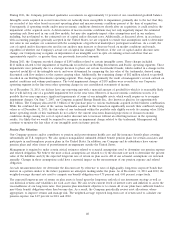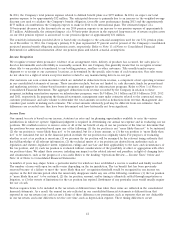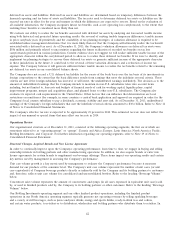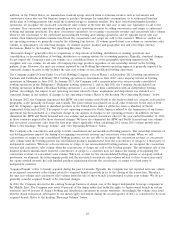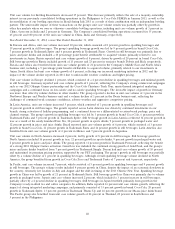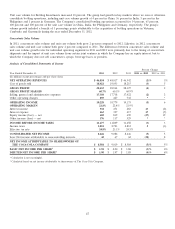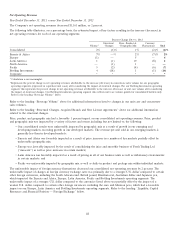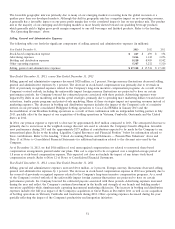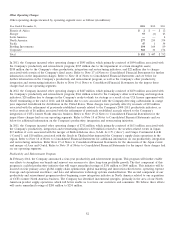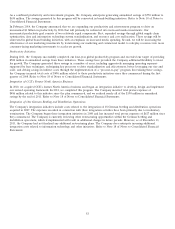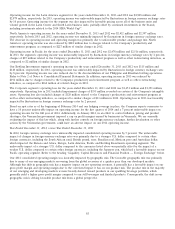Coca Cola 2013 Annual Report Download - page 48
Download and view the complete annual report
Please find page 48 of the 2013 Coca Cola annual report below. You can navigate through the pages in the report by either clicking on the pages listed below, or by using the keyword search tool below to find specific information within the annual report.Unit case volume for Bottling Investments decreased 17 percent. This decrease primarily reflects the sale of a majority ownership
interest in our previously consolidated bottling operations in the Philippines to Coca-Cola FEMSA in January 2013, as well as the
deconsolidation of our bottling operations in Brazil during July 2013 as a result of their combination with an independent bottling
partner. The unfavorable impact of these transactions on the group’s unit case volume results was partially offset by growth in
other key markets where we own or otherwise consolidate bottling operations, including unit case volume growth of 3 percent in
China, 4 percent in India and 2 percent in Germany. The Company’s consolidated bottling operations accounted for 35 percent,
65 percent and 100 percent of the unit case volume in China, India and Germany, respectively.
Year Ended December 31, 2012, versus Year Ended December 31, 2011
In Eurasia and Africa, unit case volume increased 10 percent, which consisted of 8 percent growth in sparkling beverages and
19 percent growth in still beverages. The group’s sparkling beverage growth was led by 9 percent growth in brand Coca-Cola,
7 percent growth in Trademark Sprite and 6 percent growth in Trademark Fanta. Growth in still beverages was primarily due to
juices and juice drinks and included a 10 percentage point benefit attributable to acquired volume, primarily related to our
investments in Aujan. Russia reported unit case volume growth of 8 percent, driven by growth of 20 percent in brand Coca-Cola.
Still beverage growth in Russia included growth of 13 percent and 23 percent in our juice brands Dobriy and Rich, respectively.
Eurasia and Africa also benefited from unit case volume growth of 21 percent in the Company’s Middle East and North Africa
business unit, including a 9 percentage point benefit attributable to acquired volume, primarily related to our investments in
Aujan. South Africa had unit case volume growth of 6 percent, reflecting our increased marketing initiatives in 2012 and the
impact of the volume decline reported in 2011 due to unfavorable weather conditions and higher pricing.
Unit case volume in Europe declined 1 percent, which consisted of a 2 percent decline in sparkling beverages and minimal growth
in still beverages. Germany reported unit case volume growth of 1 percent, reflecting the Company’s strong commercial campaigns
such as our 2012 Olympic Games partnership and the Coca-Cola Christmas Truck Tour, music-themed integrated marketing
campaigns and a continued focus on low-calorie and no-calorie sparkling beverages. The favorable impact of growth in Germany
was more than offset by volume declines in other markets. The group reported a decline in unit case volume of 3 percent in the
Northwest Europe and Nordics business unit and a volume decline of 1 percent in the Iberia business unit, reflecting the
challenges of continued weak consumer confidence, adverse weather and aggressive competitive pricing.
In Latin America, unit case volume increased 5 percent, which consisted of 3 percent growth in sparkling beverages and
12 percent growth in still beverages. The growth reported across Latin America was driven by continued investments in our
brands, strong activation of holiday programming, and a continued focus on a differentiated occasion-based package, price and
channel strategy. The group’s growth in sparkling beverages was led by 3 percent growth in brand Coca-Cola, 6 percent growth in
Trademark Fanta and 5 percent growth in Trademark Sprite. Still beverage growth in Latin America reflected 34 percent growth in
teas as a result of the newly launched Fuze Tea, 28 percent growth in sports drinks, 9 percent growth in packaged water and
12 percent growth in juices and juice drinks. Brazil reported unit case volume growth of 6 percent, which consisted of 3 percent
growth in brand Coca-Cola, 11 percent growth in Trademark Fanta and 16 percent growth in still beverages. Latin America also
benefited from unit case volume growth of 4 percent in Mexico and 7 percent growth in Argentina.
Unit case volume in North America increased 2 percent, led by growth of 8 percent in still beverages. Still beverage growth in
North America included 16 percent growth in teas, 12 percent growth in sports drinks, 9 percent growth in packaged water and
2 percent growth in juices and juice drinks. The group reported 11 percent growth in Trademark Powerade, reflecting the benefit
of a strong 2012 Olympic Games activation. Growth in teas included the continued strong growth of Gold Peak, and the group’s
juices and juice drinks benefited from 7 percent growth in Trademark Simply. Dasani had unit case volume growth of 10 percent
and maintained its premium pricing position, supported by our PET packaging. The group’s growth in still beverages was partially
offset by a volume decline of 1 percent in sparkling beverages. Although overall sparkling beverage volume declined in North
America, the group benefited from growth in Coca-Cola Zero and Trademark Fanta of 7 percent and 6 percent, respectively.
In Pacific, unit case volume increased 7 percent, which consisted of 5 percent growth in sparkling beverages and 9 percent growth
in still beverages. The group’s volume results included 4 percent growth in China, despite the impact of an economic slowdown in
the country, extremely wet weather in July and August and the shift in timing of the 2013 Chinese New Year. Sparkling beverage
growth in China was led by growth of 21 percent in Trademark Fanta. Still beverage growth in China was primarily due to volume
growth in packaged water. Japan’s unit case volume increased 2 percent, which included a 3 percent increase in still beverages,
partially offset by a 2 percent decline in sparkling beverages. Still beverages in Japan benefited primarily from growth in the
Company’s ready-to-drink tea and coffee categories. In addition, India reported 16 percent unit case volume growth, reflecting the
impact of strong integrated marketing campaigns, and primarily consisted of 33 percent growth in brand Coca-Cola, 20 percent
growth in Trademark Sprite, 13 percent growth in Trademark Thums Up and 26 percent growth in our Maaza juice drink brand.
The Pacific group also benefited from unit case volume growth of 22 percent in Thailand, 20 percent in South Korea and
5 percent in the Philippines.
46






